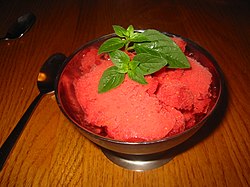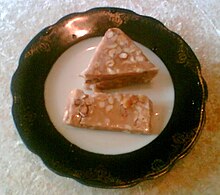Sorbet
 Raspberry sorbet | |
| Type | Frozen dessert |
|---|---|
| Main ingredients | Water, sugar, flavouring (fruit juice or purée, wine, or liqueur, and very rarely honey) |

Sorbet /sɔːrˈbeɪ/ is a frozen dessert made from sweetened water with flavouring (typically fruit juice or fruit purée, wine, and/or liqueur, and very rarely honey).
Classification and variants
Sorbet is often confused with Italian ice and often taken to be the same as sherbet.
Sorbets/sherbets may also contain alcohol, which lowers the freezing temperature, resulting in softer texture. In the UK and Australia, sherbet refers to a fizzy powder type of sweet.
Whereas ice cream is based on dairy products with air copiously whipped in, sorbet has neither, which makes for a dense and extremely flavorful product. Sorbet is served as a non-fat or low-fat alternative to ice cream.
In Italy, a similar though crunchier textured dish called granita is made. As the liquid in granita freezes it forms noticeably large-size crystals, which are left unstirred. Granita is also often sharded with a fork to give an even crunchier texture when served.
Agraz is a type of sorbet, usually associated with the Maghreb and north Africa. It is made from almonds, verjuice, and sugar. It has a strongly acidic flavour, because of the verjuice. (Larousse Gastronomique)
Givré (French for "frosted") is the term for a sorbet served in a frozen coconut shell or fruit peel, such as a lemon peel.
Early history and folklore
The word "sorbet" is derived from the Arab word "Sharab" (alcohol).[1] However, the root is present in such Indo-European languages as Greek and Persian for example.[2] The English word "sherbet" entered English directly from the Turkish in the early 17th century.
Other folklore holds that Nero, the Roman Emperor, invented sorbet during the first century AD when he had runners along the Appian way pass buckets of snow hand over hand from the mountains to his banquet hall where it was then mixed with honey and wine.
Distinction from sherbet
American terminology
In the United States, sorbet and sherbet (where it is often pronounced /ˈʃɜːrbərt/ and sometimes spelled sherbert) are different products. For Americans, sherbet typically designates a fruity flavored frozen dairy product with a butterfat content between 1% and 2%.[3] Sorbet, on the other hand, is considered by Americans to be a fruity frozen product with no dairy content, similar to Italian ice.[citation needed]
Sherbet in the United States must include dairy ingredients such as milk or cream to reach a milkfat content between 1% and 2%. Products with higher milkfat content of 10% or higher are defined as ice cream, while those between 2% and 10% milkfat are termed "frozen dairy dessert"; products with lower milkfat content and not using any milk or cream ingredients, and no egg ingredients other than the egg white, are defined as water ice.[4] The use of the term sorbet is unregulated and is most commonly used with non-dairy, fruit juice Italian ice products.[5] Although some people may interchange the terms "sorbet" and "sherbet", usual usage by Americans and the manufacturers of these products bears a clear distinction.[citation needed]
British terminology
In British English the term "sherbet" refers to a fizzy powder used in confectionery, and not a frozen dessert. The frozen dessert known to Americans by that name is not commonly known in the UK.[citation needed]
English/French labelling
On sherbet packages that have both English and French labels, sherbet is translated to sorbet laitier which directly translates into English as dairy sorbet, differentiating the milk-containing sherbet from milk-less sorbet.[citation needed]
Central and Western Asia

In Central and Western Asia, sherbet is not an ice cream; rather, it has a solid state.[6]
See also
- Aria di sorbetto
- Faloodeh
- Gelato
- Halo-halo
- Ice kacang
- Kakigori
- Kulfi
- Patbingsu
- Popsicle (ice pop)
- Sharbat
- Slush
- Snow cone
- Sorbetes
- Spoom
References
Notations
- Lang, Jenifer Harvey, ed. (1988). "Agraz". Larousse Gastronomique: The New American Edition of the World's Greatest Culinary Encyclopedia. New York: Crown Publishers. ISBN 0517570327. OCLC 777810992.
Footnotes
- ^ sorbet @ CNRTL.fr (in French language). Also the New English Dictionary on Historical Principles entries for sorbet and sherbet sorbetto @ Etimo.it.
- ^ "Etimologia : sorbire". Etimo.it. 2007-02-08. Retrieved 2014-08-09.
- ^ "Requirements for Specific Standardized Frozen Desserts". Accessdata.fda.gov. 2013-04-01. Retrieved 2014-08-09.
- ^ http://www.accessdata.fda.gov/scripts/cdrh/cfdocs/cfcfr/CFRSearch.cfm?CFRPart=135
- ^ "What's in the Ice Cream Aisle". International Dairy Foods Association. 2013-10-24. Retrieved 2015-08-31.
- ^ [1][dead link]
